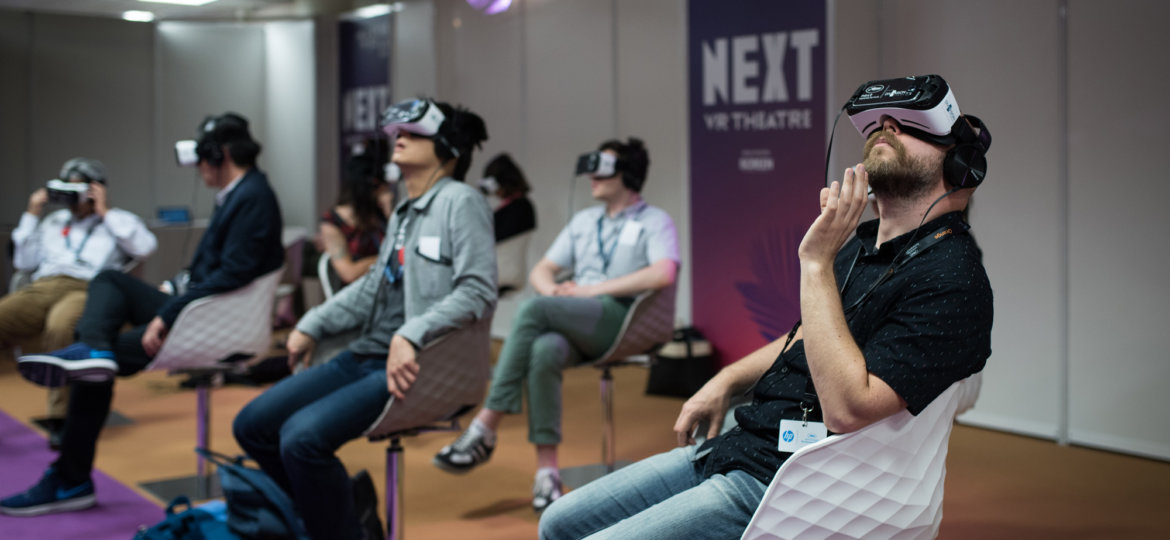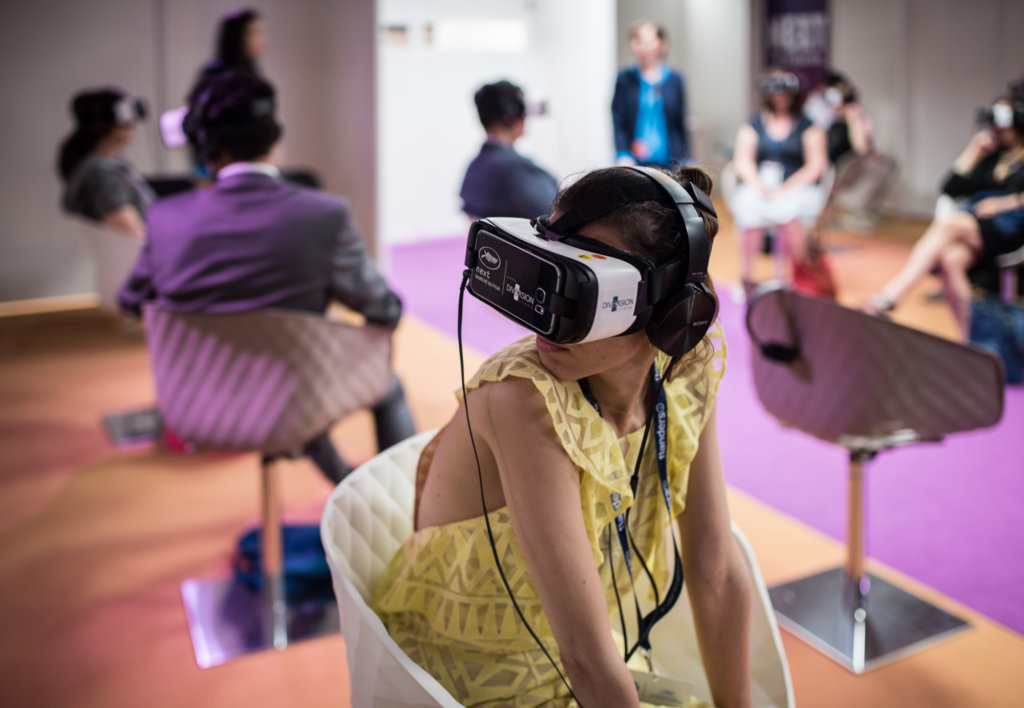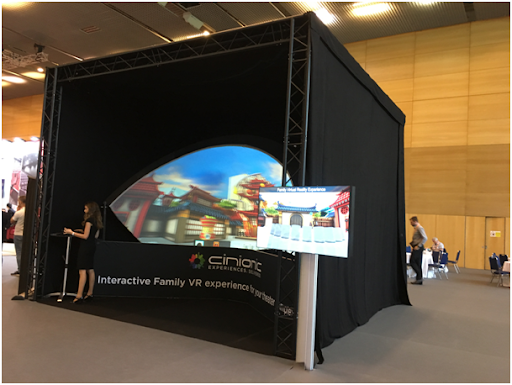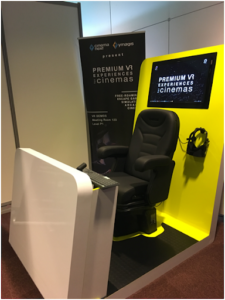
by Cécile Dumas
Introduction
Virtual Reality and other forms of immersive media have the potential of disrupting the entire media industry with new user experiences that are more immersive and interactive compared to current video, cinema and TV. In order to reach a mature state beyond the current niche markets, the quality of experience of VR media has to be improved in several ways. Immersify is developing key tools for allowing the next generation of immersive media applications, integrating high quality video in seamless media presentations and contributing to create new immersive contents.
To allow the widespread of these tools and immersive content, and contribute to their distribution and exhibition, Immersify needs to build a link between research and market, particularly in the field of cinema and entertainment industry. That’s why we are working to have a market watch on immersive experiences in cinemas, exploring and benchmarking new experiences and market trends.
Benchmarking the Film Industry
In May in Cannes, NEXT as the innovation hub of the Marché du Film brings a good opportunity to present new models and technologies to the professionals of the film industry. Over the last 4 years, NEXT has been providing a market watch on innovation in the film industry. It allowed a widespread of tools and immersive content and has contributed to its distribution and exhibition.
Thus as a partner of Immersify, the Marché du Film – Festival de Cannes has taken the role of benchmarking the potential links between the Immersive research/project and the market, particularly in the field of cinema and entertainment industry.
In order to implement this benchmark, we participated in different events and discussed with providers and exhibitors to learn and report on their various projects (cinema chains, theaters architects and equipment manufacturers, including Imax and 3 screen screenings). For example, we attended some cinema exhibitors’ trade shows like the Congrès des Exploitants, Deauville, France; CinEuropa, Barcelona. We established contacts and regular discussions with their representative bodies.
Distribution and Exhibition: Key issue
The question of distribution and exhibition is a key issue. Distribution/Exhibition of the new immersive content remains a real challenge for the film industry. The tools created by Immersify for the next generation of immersive media are definitely susceptible to help solve some distribution and exhibition difficulties.
Immersion is an exciting innovation for so many artistic experiences, and particularly in the film industry. At CineEurope, the European cinema exhibitors trade show, where the latest developments in cinema exhibition are presented, immersive experiences were at the centre of many discussions. Main new technology showcased were:
- Premium Large Format for screen (such as ScreenX, a 270-degree moving experience, expanding the scene onto the side walls, installed recently in Pathé La Villette in Paris, or Barco Escape),
- Direct View Displays (Sony, Samsung),
- Motion seats (D-Box, 4DX, 4D E-motion),
- Laser projection
Some of them were connected with VR experiences and all of them were highlighting their immersive power.
Location Based Entertainment (LBE)
Most of the experts are confirming that the B2C market for VR in HMD (head mounted display) is far from mature and that it can still take 5 – 8 years to reach the home entertainment market mainly because the technical materiel is changing too fast and is too expensive, and the offer on app or platform is still confused for a simple user.
However, the exhibition model for VR/Immersive content is clearly developing as one of “Location Based Entertainment” (LBE). LBE spaces are now rapidly developing mostly showing VR experiences. The industry is moving towards the creation in cinema theatres, museums, malls, or dedicated places, of spaces similar to old arcade game centers.
It is interesting to see that the immersive experience is becoming an argument to promote the cinema theater as one of the place for exhibition, particularly compared with a home experience, or an individual smartphone experience, or any other kind of entertainment.
Also, movie screens/theatres are developing technologies to bring immersion into the cinema experience, and new immersive contents are looking for exhibition. It could be a natural crossing-point although there are not yet some sustainable solutions and it is at the stage of research and testing, but it will evolve quickly.
In Linz, at Ars Electronica (one of the Immersify partners), the Deep Space was discussed in those terms: “Never call it a movie theatre!”. The Deep Space is viewed as a space for research and development – the cutting-edge side of the approach – to invent a way to propose collective immersive experiences that can be embedded by the professionals who deal with exhibition as a business practice. There might not be hundreds of deep spaces in the cinema theatres or entertainment spaces in the next future but it is an essential part of the fast evolving developments and attempts to exhibit immersive experiences in the best conditions for the audience.
Some LBE Initiatives
Here is look on various LBE initiatives we could benchmark.
Escape Game centers
One of the pioneer is The Void (USA) which is an escape game using their own tools and their own content for a collective experience.
Virtual Room in Paris was created to propose a collaborative collective experience, close to gaming and escape game with a scenarized adventure and now developed in some places in the world. They produce their own content.
Another one is Virtual Adventure with a Sci-Fi experience “Eclipse” selected in Venice VR this year.
Many other centers are developed in London, UK (The VR concept, DNA VR) or in the USA. For example Dreamscape Immersive, created by Swiss researchers from Artanim foundation, also proposes immersive cinematic creations for their own location based entertainment centers. They now develop alongside pop-ups and shop-in-shop concepts.
Artanim Dreamscapes
Those proposals are close to gaming experience but they interact with the attendees, propose different stories in an entertainment world. They have their place in this market review.
VR Cinemas
Other initiatives are more linked to the cinematic world.
Diversion Cinema creates movie theaters to discover VR movies and experiences, in curated programs, together with other spectators. They operate their VR cinemas in partnership with exhibitors who host them. They also operate services for festival such as Festival de Cannes at Marché du Film or Venice festival. They keep an eye on dome development too.
They are not alone on these VR Cinema proposals. There are also other companies on those kind of offer in Belgium, in Germany with InVR Space.
They have also created recently an international sales department to distribute VR content throughout the world to different type of channels.

VR Centers
Mk2 VR is born in the frame of a cinema exhibitor group. They propose a first dedicated space for VR, located in the lobby of one of their cinemas. The experiences are made individually in a space with about twelve various experiences and VR facilities (HMD, Birdly, Positron). In their offer, they are closed to Imax in the USA or SoReal in China (VR center). They also propose now a independant and complete solution “Mk2 vr pod”, providing material, operational maintenance and content via a curated platform, close to cinema studio particularly.
Special installations
Some initiatives are also based on a specific content. DV group, who creates a interactive VR experience with Alice from Lewis Caroll’s novels, are now working on a premium LBE in London, including VR experiences and drink and food services.
In Austria, Amilux Film, for their movie Balavista, has created a special cube-like immersive cinema – 4 walls and a deck, with dimensions 10 m x 10 m x 10 m.
Spin Digital and Amilux had two meetings this year, one in Cannes and another in Berlin, to discuss how the Immersify can help to enhance the visual experience in this kind of installations. Amilux also mentioned the special interest that some Japanese parties have in this kind of immersive projections. The problem is that much smaller dimensions are required in Japan, so alternative screening technologies might be needed.
Suppliers
Several suppliers, coming from the cinema industry, develop offers for the LBE centers. It can be turn-key center or a range of operational services.
For example, there is an initiative by CinémaNext/Ymagis a company well-connected to cinema exhibitors in Europe. They develop a whole multi-experiences VR concept including solutions developed by other companies, such as connected pods (Hestia by VR Connection), gaming experience (Backlight with DBox), Free-roaming space. They will test the entire concept in a showroom coming soon in Paris.
In the same way, we observe many pod solutions developed in the last few months for VR exhibition: Hestia by VR Connection, Diversion cinema, HeRVé, etc.
We can also talk about the Belgian company Barco specialised at first in cinema projectors, who takes a great account of immersive question and develop a new venture B.Immersed to propose immersive solution to the market.
At last we can talk about the Canadian Dbox. They say they are leader for immersive cinemas with their well-known moving seats, and propose also VR experiences connected to their seats. They propose a collective VR concept for CinePlex in Ottawa but are now focused on the operability to secure all the practical questions for exhibitors and note that a business model is about to be confirmed. They are optimistic on the question of content developments. Certainly because they are working in partnership with great north american content producers such as Felix et Paul or research program with SAT. And they continue to develop new technological projects, such as an haptic floor for fulldome with SAT.
In the USA, as another example, SpringboardVR is a station management, game launching and content distribution platform for location-based VR.[/vc_column_text][/vc_column][/vc_row]


Role of Festivals
Technology for LBE is moving fast and is almost ready to widespread but the professionals we met are all worrying about getting enough content of quality.
Festivals are a huge opportunity to identify quality contents. It’s also a driving force for developing new exhibition solutions, individually such as VR Library or collectively such as VR cinemas. It is also a good way to promote innovation and support project development when the festivals are proposing a market or industry gathering.
Over the last four years, film festivals and markets have all included VR and immersive content in their programming. To name the most important ones: Sundance, Tribeca, Venice, Berlinale, Marché du Film – Festival de Cannes, GIFF (Geneve), Annecy MIFA, Paris NewImages festival, Göteborg, VR Days in Amsterdam, Stereopsia in Brussels, Virtuality in Paris, Locarno in Switzerland, Sheffield Doc Fest, Sunny Side of the Docs, etc.
Many other events are wide spreading the audience for VR such as short films festivals or festival well-known for other artistic discipline such like Arles, for photography, in France, the Dance Biennale in Lyon, France. And of course Ars Electronica Festival with a general view on media arts.
Market Potential
It’s a bit early to have a precise and secured view on the market potential but following the existing literature (in the media and cinema professional press) and the conferences in tradeshows, we can draw a strong rising trend for LBE development.
At NAB Show, in April 2018 in Las Vegas, Greenlight Insights, a company specialised in virtual and augmented reality market intelligence, forecasts, in its “Location-based VR annual report” a $1 billion market by year’s end, representing about 7% of the VR industry, and by 2023, location-based entertainment will grow to a $12 billion market representing about 11% of the VR industry.
Conclusions
Taking into account our market observations and regular talks with professionals, we can raise the following conclusions :
- Immersive technology provides a great development for many artistic experiences and immersive experiences can bring new opportunities for cinema theatres.
- Cinema theaters but also specialised spaces are now testing different approaches for Location Based Entertainment and the immersive/VR content offer is now growing. A market structuration is coming, favourable to the development of LBE venues using different technologies.
- The market is now structuring itself with the arrival of specialised distributors (Mk2 vr, Diversion, Dogwoof, VRroom) to propose a catalogue of contents, spotted in the festivals, to those LBE venues. It’s a good news because it’s a real need from both sides.
- There is also another challenge to develop the proposals in public spaces (cinema, LBE): be operational! Work on the operational efficiency to be easy to install, easy to use, to be able to deal with numbers of attendees and to ensure a profitability.
